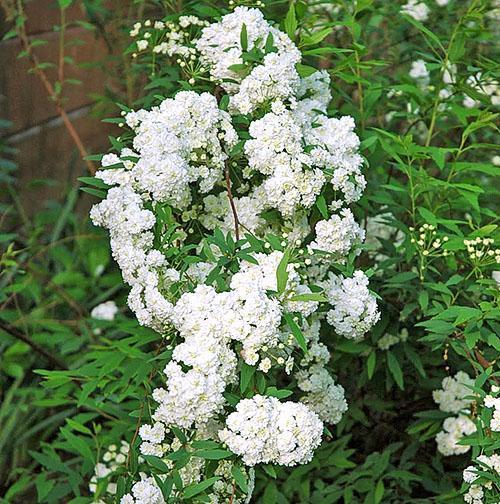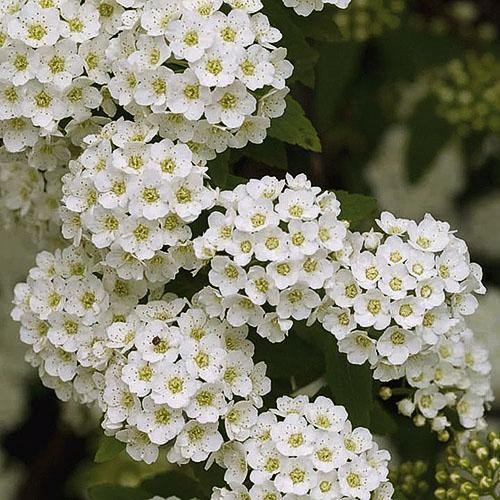Planting and caring for the Wangutta spirea in the personal plot
 Blooming spirea Wangutta does not leave indifferent either experienced gardeners or novice plant growing lovers. And it's not only the amazing shoots strewn with white flowers, but also the unpretentiousness of this ornamental shrub, the ease of planting and caring for the Wangutta spirea. This variety of spirea has been cultivated since 1868, and was obtained thanks to the efforts of breeders who crossed the plants of Cantonese and three-lobed spirea. The result was a plant with a 2-meter crown, which, during flowering, turns into a cascade of shoots strewn with snow-white flowers.
Blooming spirea Wangutta does not leave indifferent either experienced gardeners or novice plant growing lovers. And it's not only the amazing shoots strewn with white flowers, but also the unpretentiousness of this ornamental shrub, the ease of planting and caring for the Wangutta spirea. This variety of spirea has been cultivated since 1868, and was obtained thanks to the efforts of breeders who crossed the plants of Cantonese and three-lobed spirea. The result was a plant with a 2-meter crown, which, during flowering, turns into a cascade of shoots strewn with snow-white flowers.

If in the 19th century botanists managed to obtain a spirea with only white five-petal flowers and dark green leaves, today there are forms with pink and double flowers, as well as with variegated very decorative foliage.
This expands the possibilities of using spirea in landscape design and expands the circle of fans of this amazing plant.
Spirea Wangutta requirements for soil and planting site
 Truly abundant flowering of the Wangutta spirea can be achieved only if the plants receive enough sunlight. If a spirea hedge or free-standing shrubs are in the shade, you should not wait for a scattering of white flowers on the shoots. For the rest, the plant is unpretentious and does not require special care about the planting site. Growing and caring for spirea can be further simplified if optimal conditions are created for the growth of the shrub.
Truly abundant flowering of the Wangutta spirea can be achieved only if the plants receive enough sunlight. If a spirea hedge or free-standing shrubs are in the shade, you should not wait for a scattering of white flowers on the shoots. For the rest, the plant is unpretentious and does not require special care about the planting site. Growing and caring for spirea can be further simplified if optimal conditions are created for the growth of the shrub.
Like all members of the family, Wangutta spirea is more like loose, well-drained soils with a moderate amount of nutrients and an acidity of 6 to 7 units.
The best soil is a mixture of two parts of sod land, one part of sand and the same volume of low-lying peat:
- Peat or sand is introduced into dense loamy soils or black soil before planting spireas.
- Loamy sands, poor in organic matter, are enriched with humus and mineral additives.
- Excessively acidic soil on the site must be deoxidized.
Planting spirea Wangutta and caring for seedlings
 For spirea shrubs, autumn planting is preferable. If it is not possible to plant a seedling in the ground before mid-October, you can do this in the spring, until the active movement of juices begins. Even large bushes of Vangutta spirea acclimatize well after transplantation. The main thing is that the plant that has got to a new place:
For spirea shrubs, autumn planting is preferable. If it is not possible to plant a seedling in the ground before mid-October, you can do this in the spring, until the active movement of juices begins. Even large bushes of Vangutta spirea acclimatize well after transplantation. The main thing is that the plant that has got to a new place:
- had enough space for the root system;
- did not experience a lack of nutrition and moisture;
- managed to take root before the onset of frost.
As a rule, the addiction of seedlings with an open root system is more painful, but young bushes that fall on the site in containers and are transferred to the ground along with an earthen clod immediately start growing. Therefore, planting and caring for a spirea in this case is much easier, and you can plant a shrub at any warm season.
A tall shrub of this species is perfect for both single plantings and for use in hedges.In both cases, the pits under the spirea should be 20-25% larger in volume than the root system of the seedling.
It should be borne in mind that a drainage layer with a thickness of 7 to 20 cm is provided at the bottom of the planting pit, depending on the type of soil and the occurrence of groundwater.
If the Wangutta spirea shrub is used:
- in a single planting, the plant hole should have a depth of 50 cm and the same diameter;
- in groups, the distance between adjacent seedlings should not be less than 0.7–1.5 meters.
- in a spirea hedge, then holes for planting are dug at a distance of half a meter between individual plants and adjacent rows.
Spirea care begins immediately after planting. The trunks are well compacted and watered with warm water in order to wet the entire root system of the bush. To conserve moisture, the soil under the crown is mulched with peat.
Wangutta spirea bush care
 All measures for growing and caring for the Wangutta spirea are reduced to regular watering plants, weeding and shallow loosening of the soil in the near-trunk circle, pruning and feeding. In the dry season, as well as after pruning, spirea bushes are watered so that the soil is soaked to a depth of about half a meter.
All measures for growing and caring for the Wangutta spirea are reduced to regular watering plants, weeding and shallow loosening of the soil in the near-trunk circle, pruning and feeding. In the dry season, as well as after pruning, spirea bushes are watered so that the soil is soaked to a depth of about half a meter.
Weeding and loosening the soil will improve soil aeration, the plant will receive more moisture, nutrition and oxygen. To reduce the amount of irrigation water, you can use mulching.
 Spirea hedges of this species easily tolerate sanitary cutting, but it is important to take into account that flower buds develop on the shoots of the second year of life, and pruning should not affect them. But after flowering, nothing prevents the gardener from cutting off the faded shoots, and completely shortening the old ones to a strong bud, from which a new powerful branch will appear. During sanitary pruning, branches over 7 years of age are removed, lateral shoots shading the crown and shoots with traces of diseases and the presence of pests.
Spirea hedges of this species easily tolerate sanitary cutting, but it is important to take into account that flower buds develop on the shoots of the second year of life, and pruning should not affect them. But after flowering, nothing prevents the gardener from cutting off the faded shoots, and completely shortening the old ones to a strong bud, from which a new powerful branch will appear. During sanitary pruning, branches over 7 years of age are removed, lateral shoots shading the crown and shoots with traces of diseases and the presence of pests.
 After removing weak and interfering shoots with growth, the spirea shrub quickly recovers. Plants and frost are not strongly affected. Even if some of the shoots are damaged by frost, after pruning, the green mass soon resumes.
After removing weak and interfering shoots with growth, the spirea shrub quickly recovers. Plants and frost are not strongly affected. Even if some of the shoots are damaged by frost, after pruning, the green mass soon resumes.
To support the forces of the shrub, complex plants for ornamental crops are introduced under the roots before flowering. The same feeding will not hurt before the onset of cold weather.
Spirea in landscape design: photos and examples of use
 Plants of this species have found the widest application as spirea hedges, which help not only hide the site from prying eyes, but also become its true decoration.
Plants of this species have found the widest application as spirea hedges, which help not only hide the site from prying eyes, but also become its true decoration.
A voluminous bush with drooping shoots will look good against the background of other ornamental crops, such as mock orange or lilac. The Vangutta spirea shrub is good both in group and in single plantings. It will not be lost anywhere and will become the center of any composition.
Good neighbors for the Wangutta spirea will be relatives of the summer flowering time intercepting the baton.
 From a photo of a spirea in landscape design, one can judge the versatility and high decorativeness of this plant in different seasons. In spring, shrubs are early covered with beautiful green or variegated foliage, followed by abundant flowering, lasting up to three weeks. And even after him, the spirea Wangutta does not lose its charm. By autumn, its leaves take on a variety of shades of yellow, orange, red and deep purple.
From a photo of a spirea in landscape design, one can judge the versatility and high decorativeness of this plant in different seasons. In spring, shrubs are early covered with beautiful green or variegated foliage, followed by abundant flowering, lasting up to three weeks. And even after him, the spirea Wangutta does not lose its charm. By autumn, its leaves take on a variety of shades of yellow, orange, red and deep purple.